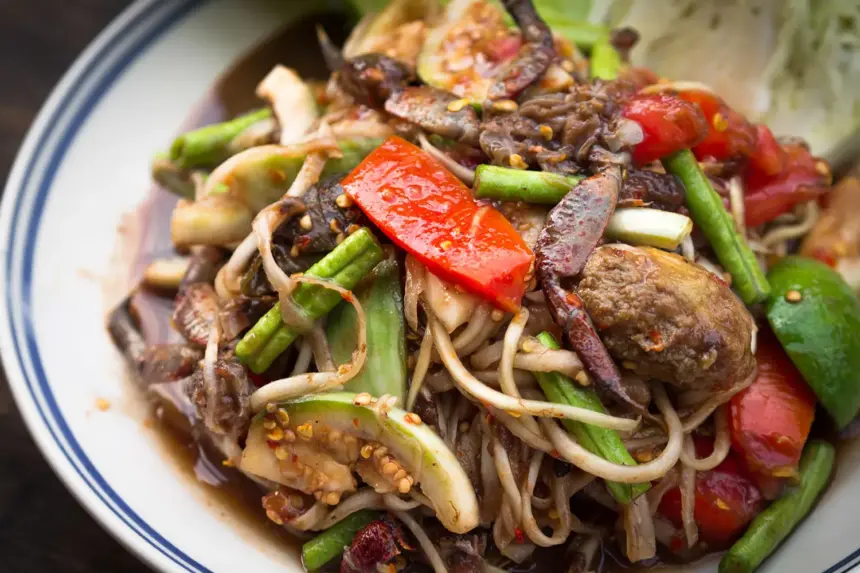Thai Food: Som Tam – Green Papaya Salad – A Tangy Delight of Thai Cuisine
Som Tam, also known as green papaya salad, is one of Thailand’s most beloved and iconic dishes. Renowned for its unique balance of flavors—spicy, sweet, sour, and salty—Som Tam is a refreshing, crunchy salad that captures the essence of Thai cuisine in every bite. Originating in the northeastern region of Thailand, known as Isaan, this dish has gained global recognition and can be found in Thai restaurants worldwide. It’s simple yet bursting with vibrant flavors, making it a favorite among locals and travelers alike.
In this article, we’ll explore the history of Som Tam, the ingredients and preparation methods, its variations, cultural significance, and health benefits.
A Brief History of Som Tam
Som Tam, also spelled “Som Tum,” has its roots in the Isaan region of Thailand, which is known for its intensely flavorful and rustic dishes. The dish’s name reflects its character: “som” means sour, and “tam” means to pound. The traditional preparation involves pounding ingredients in a mortar and pestle (krok in Thai), which is a defining aspect of Som Tam.
Though green papaya is now synonymous with Som Tam, the dish likely evolved from earlier versions made with other local ingredients. Some believe it has Laotian origins and migrated into northeastern Thailand, where it was embraced and adapted by the Isaan people. Today, Som Tam is enjoyed across all regions of Thailand and has made its mark on the global culinary scene.
Ingredients of Som Tam
What makes Som Tam truly unique is its ability to harmonize a wide range of flavors and textures. The base of the salad is shredded green papaya, which is firm, crisp, and slightly tangy in its unripe form. Green papaya provides a neutral canvas for the bold dressing and spices that give the dish its signature taste.
Here’s a breakdown of the key ingredients typically found in a classic Som Tam:
- Green Papaya: Unripe papaya is peeled, deseeded, and shredded into thin strips, forming the bulk of the salad. It has a mild flavor and a crunchy texture, ideal for absorbing the dressing.
- Chilies: Fresh Thai chilies (prik kee noo) are pounded into the salad, giving it the iconic heat that Thai food is known for. The number of chilies used can vary depending on how spicy the diner prefers the dish.
- Garlic: Crushed garlic adds a sharp, pungent flavor that enhances the overall complexity of the salad.
- Lime Juice: Freshly squeezed lime juice is essential to create the bright, sour notes in Som Tam. It provides a refreshing tang that balances out the spiciness and saltiness.
- Fish Sauce: Known as nam pla in Thai, fish sauce adds a deep, savory umami flavor. It’s a key ingredient in Thai cuisine and contributes the salty element to Som Tam.
- Palm Sugar: Palm sugar is used to add sweetness to the dressing, which balances out the sourness from the lime and the heat from the chilies.
- Tomatoes: Fresh tomatoes, usually cherry or Roma, are sliced and added to the salad for a burst of sweetness and moisture.
- Long Beans: Often cut into small segments, long beans add another layer of crunch to the dish.
- Dried Shrimp: Small, dried shrimp provide a briny flavor that complements the fresh ingredients. They also add a bit of chewiness to contrast with the crunchy vegetables.
- Peanuts: Roasted peanuts are usually sprinkled on top of the salad, adding a nutty richness and an additional layer of texture.
Preparation of Som Tam
The preparation of Som Tam is a simple yet methodical process. A traditional mortar and pestle is used to combine and lightly crush the ingredients, ensuring that they release their flavors without becoming mushy. The pounding helps the green papaya absorb the dressing while keeping its signature crunch intact.
- Start by pounding garlic and chilies together in the mortar to release their aromas.
- Add the long beans, tomatoes, and dried shrimp, and gently pound them to bruise the vegetables without breaking them apart completely.
- Next, add shredded green papaya and continue to pound while mixing in palm sugar, lime juice, and fish sauce. The goal is to lightly bruise the papaya while evenly distributing the dressing throughout the salad.
- Once the salad is well mixed and flavored, transfer it to a plate and sprinkle with roasted peanuts for a final touch of flavor and texture.
Som Tam is best enjoyed immediately after preparation when the ingredients are fresh, crisp, and full of flavor.
Variations of Som Tam
While the classic version of Som Tam (Som Tam Thai) is the most popular, there are several regional and ingredient-based variations that cater to different tastes. Here are a few common versions:
- Som Tam Thai: The traditional version, made with green papaya, lime juice, fish sauce, chilies, garlic, tomatoes, dried shrimp, and peanuts. It is the perfect balance of sweet, sour, salty, and spicy.
- Som Tam Poo: This variation includes salted black crabs (poo), which are mashed into the salad, adding a briny, savory flavor. The crabs are usually small and soft-shelled, and their flavor permeates the dish.
- Som Tam Pla Ra: For those with more adventurous palates, this version includes fermented fish sauce (pla ra), which gives the dish a stronger, more pungent aroma. It’s more common in rural areas and among locals who appreciate bold flavors.
- Som Tam Ma Muang: In this variation, green mango is used instead of green papaya. The tartness of the mango adds an additional layer of sourness, making it a favorite among those who enjoy more tangy dishes.
- Som Tam Kai Kem: Salted duck eggs are added to this version of Som Tam, contributing a rich, creamy texture and a salty, umami flavor that complements the spicy salad.
- Som Tam Moo Yor: This variation incorporates Thai pork sausage (moo yor), making it a heartier and more filling option, often served as a complete meal.
Cultural Significance of Som Tam
Som Tam is more than just a dish; it is a symbol of Thai culinary culture. In Thailand, food plays a central role in social gatherings, and Som Tam is often enjoyed communally. It is commonly paired with sticky rice and grilled meats like chicken or pork, creating a balanced and satisfying meal. In many parts of Thailand, it is customary to eat Som Tam with your hands, combining the salad with sticky rice in one bite.
Street food culture is also closely tied to Som Tam. Walk through any Thai market, and you’ll likely spot vendors pounding the salad fresh to order. The sight and sound of the mortar and pestle is a quintessential part of the experience, and diners can customize their salad to their liking, whether they want it extra spicy or mild.
Som Tam is also a representation of Isaan cuisine, which is known for its bold, rustic flavors and reliance on fresh ingredients. Isaan food has become popular throughout Thailand, and Som Tam is often the gateway dish that introduces people to the rich culinary traditions of the region.
Health Benefits of Som Tam
Som Tam is not only delicious but also packed with nutrients, making it a healthy option for those looking to enjoy Thai food without compromising on nutrition. Here are some health benefits of this vibrant salad:
- Low in Calories: Som Tam is primarily made from vegetables and a light dressing, making it a low-calorie dish perfect for those looking to maintain a healthy diet.
- Rich in Fiber: Green papaya and other vegetables used in Som Tam are high in dietary fiber, which is essential for digestive health and helps to keep you feeling full longer.
- Vitamin C: The lime juice and green papaya in Som Tam are rich in vitamin C, which boosts the immune system and supports skin health.
- Antioxidants: Ingredients like garlic, chilies, and tomatoes are packed with antioxidants that help fight inflammation and support overall health.
- Healthy Fats: The peanuts in Som Tam provide healthy fats, which are essential for brain function and heart health.
- Protein: Dried shrimp and peanuts add a good source of protein, helping to build and repair tissues.
How to Enjoy Som Tam
Som Tam is incredibly versatile and can be enjoyed as a light snack, a side dish, or part of a larger meal. It is often served with sticky rice, which balances the spiciness of the salad, and grilled meats such as gai yang (grilled chicken) or moo ping (grilled pork skewers).
For those dining in Thailand, Som Tam is best experienced at a local street food market, where vendors make the salad fresh in front of you. You can customize the spice level and ingredients to suit your personal taste. It’s also a dish that lends itself well to communal eating, making it perfect for sharing with friends and family.
If you want to try making Som Tam at home, the ingredients are widely available at Asian markets. All you need is a mortar and pestle, fresh green papaya, and a taste for bold flavors.
Conclusion
Som Tam is a true representation of Thai cuisine—vibrant, flavorful, and full of contrasts. Its blend of sweet, sour, salty, and spicy flavors offers a taste experience that is both refreshing and exciting. Whether enjoyed as a street food snack or as part of a larger meal, Som Tam is a dish that captures the heart of Thailand’s culinary heritage.
With its versatility, health benefits, and undeniable deliciousness, Som Tam remains one of Thailand’s most iconic and cherished dishes. For anyone exploring Thai food, trying Som Tam is a must, offering a unique glimpse into the country’s rich food culture.









